Snakes are not generally the first thing that comes to mind when most people think of New York. Instead, they usually think of “The Big Apple,” skyscrapers, congested traffic, and lots and lots of people. However, these images only represent a small portion of the state. Meadows, forests, farmland, mountain ranges, and wetlands cover the rest of New York, providing homes to 17 different species of snakes.
Snakes in New York are highly valued exterminators that eradicate pests like rodents and insects. Most of these snakes are harmless, but there are three venomous snakes in New York, including rattlesnakes and copperhead snakes. However, these dangerous snakes are extremely uncommon in the state and are rarely seen. Let’s look at the two types of rattlesnakes in New York.
1. Timber Rattlesnake
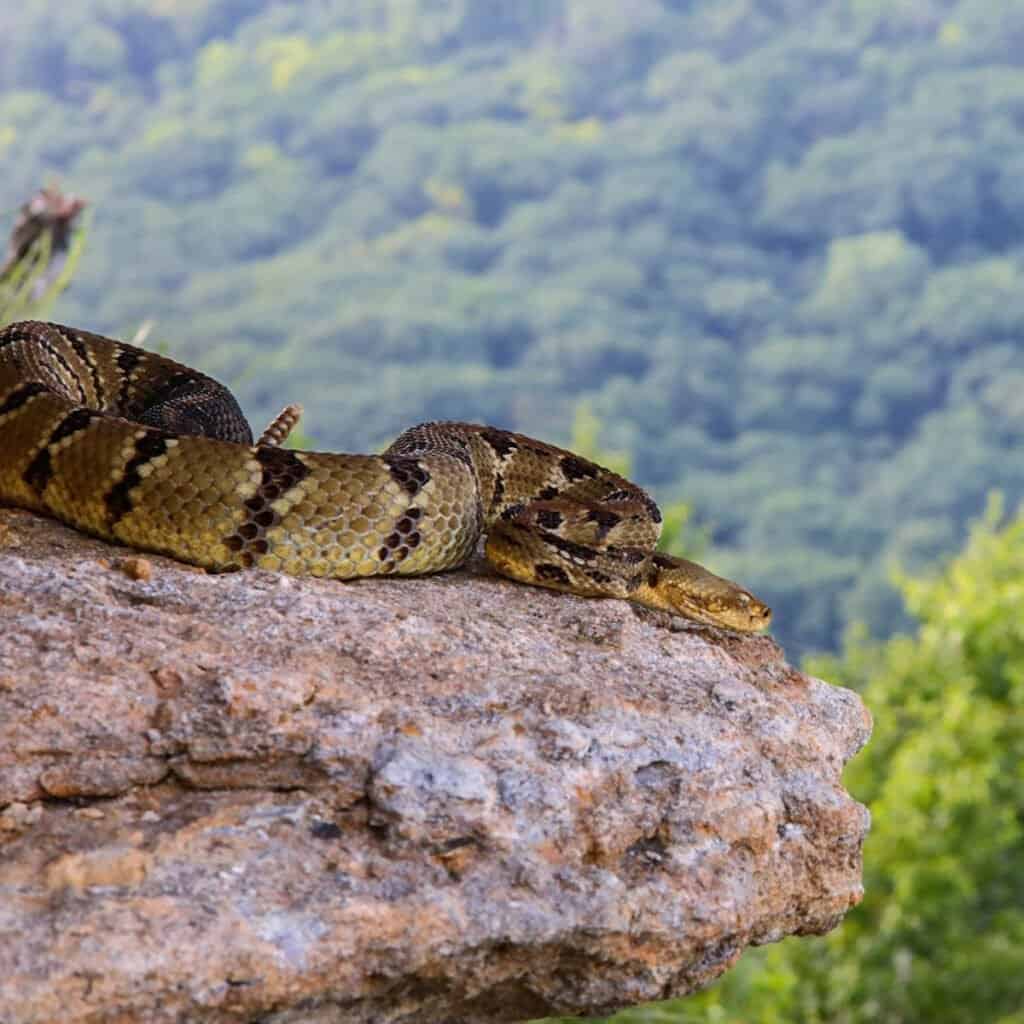
Timber Rattlesnakes like climbing trees, and have even been found nearly 80 feet above the ground!
©bradenjalexander/Shutterstock.com
| Timber Rattlesnake | |
|---|---|
| Range | Southeastern New York & Peripheral Eastern Adirondack Mountains |
| Length | 36-72 inches |
The Timber Rattlesnake is the largest venomous snake in New York. In the past, these snakes lived in many of the mountains and hills of New York. Today, however, timber rattlesnakes have decreased by 50-75%, and are only found in isolated and semi-isolated populations. Timber rattlesnakes are a “threatened species” and live in southeastern New York and the peripheral eastern Adirondack Mountains. The extreme decrease in their population here is the result of indiscriminate killing, habitat destruction and disturbance, and unregulated collection.
For many years the timber rattlesnake has been persecuted out of fear by New York locals, and in some northern counties, there were once bounties for these animals. New York outlawed this bounty in 1971, but much of the cultural fear of these snakes remains today. Timber rattlesnakes continue to suffer from illegal collection, persecution, road mortality, disturbance by human recreational activities, and urban development. The venom of the timber rattlesnake can be fatal if the bite is left untreated. However, in the past several decades there have not been any human deaths on record. In fact, less than 15% of bites in New York come from venomous snakes. Although dangerous, timber rattlesnakes will generally not attack a human unless seriously provoked or threatened.
Appearance

Be careful around Timber Rattlesnakes with well-hidden camouflage.
©Frode Jacobsen/Shutterstock.com
The longest timber rattlesnake recorded in New York was 60 inches long! However, more commonly these snakes grow between 3-4 feet in length. The colors and patterns on the snakes’ bodies help them to camouflage and blend in easily with their surroundings. Because of this, the colors of these snakes vary. In New York, timber rattlesnakes can typically be grouped into two color phases: dark and light, or black and yellow.
Dark or black timber rattlesnakes have black heads and dark brown bodies, with dark V-shaped crossbands along their backs. The patterns and coloring of some timber rattlesnakes are so dark that the snake appears almost completely black. Occasionally they also have a reddish stripe running down the middle of their backs. Although typically red, this stripe may also be tan, yellow, or light orange, and the dark crossbands often break it up into separate pieces.
Timber rattlesnakes with the light or yellow color phase have the same dark brown or black V-shaped crossbands along their bodies. However, their heads and bodies are yellow instead of brown or black. In both color phases, the crossbands eventually fade near the tail, which is solid black. This velvety-black tail is why the timber rattlesnake was once referred to as “the old velvet rattler.”
Behavior
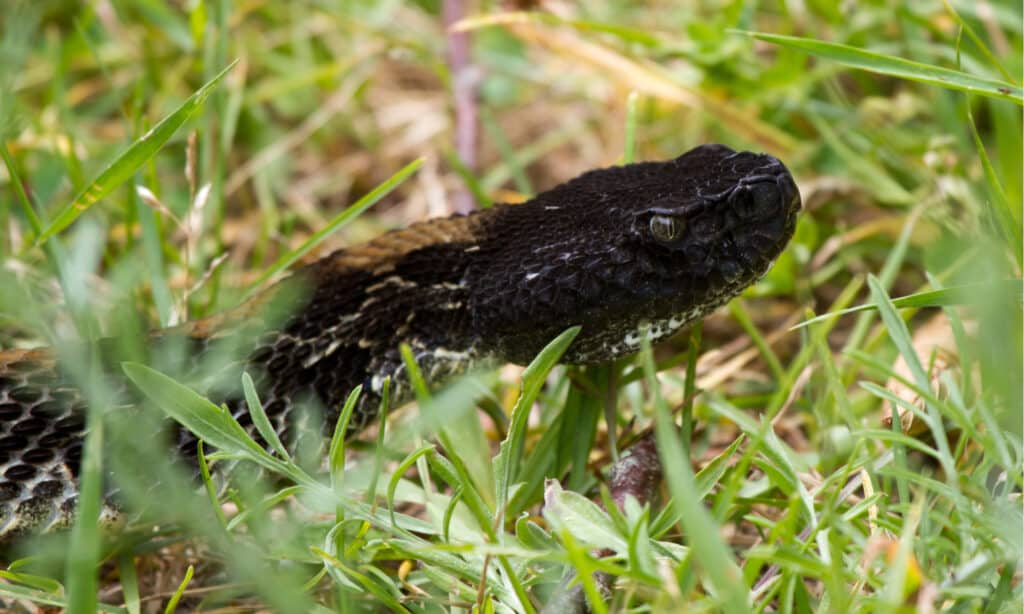
Timber Rattlesnakes are the most venomous snake in the US.
©Frode Jacobsen/Shutterstock.com
Timber rattlesnakes are most active from late April through the middle of October. These snakes migrate one to five miles away from their winter dens in search of food, basking areas, and potential mates. Timber rattlesnakes eat small to medium-sized mammals like chipmunks, squirrels, mice, and voles. They also hunt amphibians and small birds. The mating season for timber rattlesnakes occurs from early summer through early autumn. Female timber rattlesnakes can store sperm until spring when the weather is warmer. These snakes live together in communal dens throughout the winter.
Timber rattlesnakes give birth to 4-14 babies every 3-5 years in August or September. Because these snakes have such a low reproductive rate, their populations grow rather slowly. Newborn snakes, or “neonates”, look like 10–14-inch versions of adult timber rattlesnakes, complete with venomous fangs and a small keratin “button” on the end of their tails. Each time the snake sheds, it adds a new segment to this button, forming their iconic rattles. These young snakes venture out on their own after 1-2 weeks. However, in the fall they will return to their winter den by following their parent’s scent trail. Timber rattlesnakes typically live for 15-20 years. However, there are records of some wild snakes that lived to be more than 50 years old!
2. Eastern Massasauga Rattlesnake

The eastern massasauga rattlesnake rarely rattles and prefers staying still to avoid detection
©Ryan M. Bolton/Shutterstock.com
| Eastern Massasauga Rattlesnake | |
|---|---|
| Range | Fragmented populations in Central & Southwestern New York |
| Length | 18-40 inches |
The other type of rattlesnake in New York is the Eastern Massasauga, which is the smallest of the three venomous snakes in the state. The eastern massasauga rattlesnake is an endangered species in New York. It is also a federally threatened species. The populations of eastern massasauga rattlesnakes are fragmented, with only two officially recorded populations left in central and southwestern New York. Much of this snake’s habitat has been lost due to agriculture and urban development. In addition, eastern massasauga rattlesnakes suffer from illegal collecting, unregulated hunting, and indiscriminate killing due to the misunderstanding and fear of snakes.
Appearance
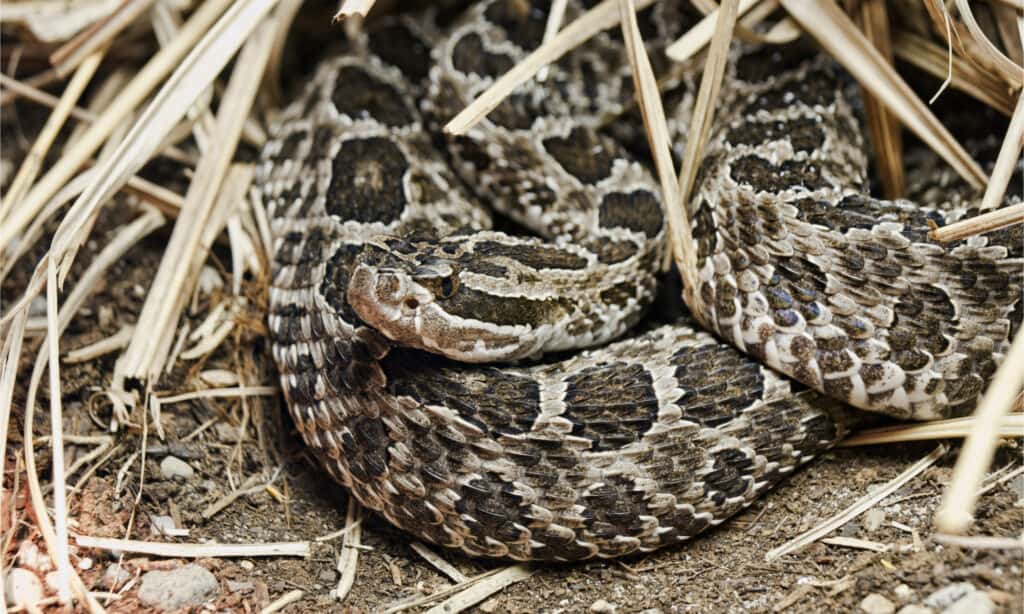
The Eastern Massasauga Rattlesnake is one of three different subspecies of the Massasauga Rattlesnake.
©DnDavis/Shutterstock.com
The eastern massasauga rattlesnake looks very different from the timber rattlesnake. These snakes are smaller, growing between 18-40 inches in length. Although their heads are broad and triangular-shaped, they are not quite wide as the timber rattlesnake snake. Eastern massasauga rattlesnakes are brownish-gray or gray in color, with distinct dark brown or black markings along their backs. These markings are shaped like chubby bowties or hourglasses. They also have rows of smaller dark spots along each side of their stout bodies. On their faces, eastern massasauga rattlesnakes have a lightly bordered dark stripe running from each eye to the back of their jaw.
Behavior
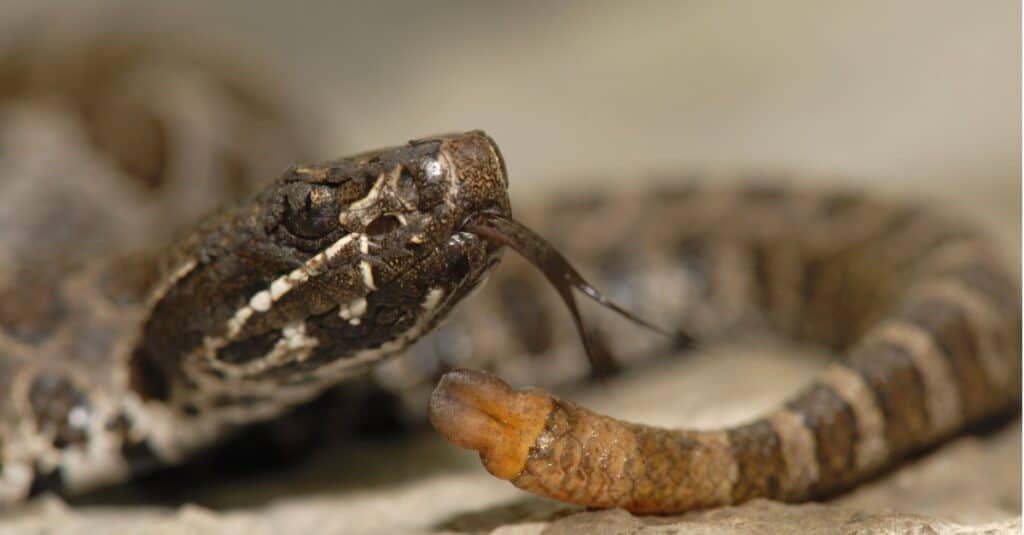
A small Massasauga rattlesnake with only one button on its tail. The rattle is actually a series of interlocking scale segments, which make a buzzing noise when the tail is vibrated.
©iStock.com/Shoemcfly
The word “Massasauga” comes from the Chippewa language and means “great river-mouth”. Like their name, eastern massasauga rattlesnakes prefer wet habitats, like the swamps, bogs, and wet prairies of New York. However, these snakes use different environments for different purposes, depending on the season. In the spring and fall, for example, eastern massasauga rattlesnakes utilize wetter habitats mixed with both sunny and shady areas. In the summer, however, they branch out and move upland into nearby fields and forests to forage for food. During the winter these snakes use moist root systems and sphagnum hammocks for warmth and brumation. Unlike many other snake species who share communal dens in the winter, eastern massasaugas brumate alone.
Eastern massasauga rattlesnakes are typically active during the day. However, when temperatures get too hot, these snakes will switch to early mornings and late nights for foraging. Mating season runs from late April through September, and baby rattlesnakes are born the next year in the middle of August or September. Eastern massasauga rattlesnakes give birth to live young every 2-3 years. Baby rattlesnakes are around 6 ½ to 9 ½ inches in length. These snakes live to around 14 years of age and primarily eat small rodents. However, they will also hunt other snake species, and sometimes even eat small birds or frogs.
What to do if You Encounter a Rattlesnake in New York: Don’t Panic!
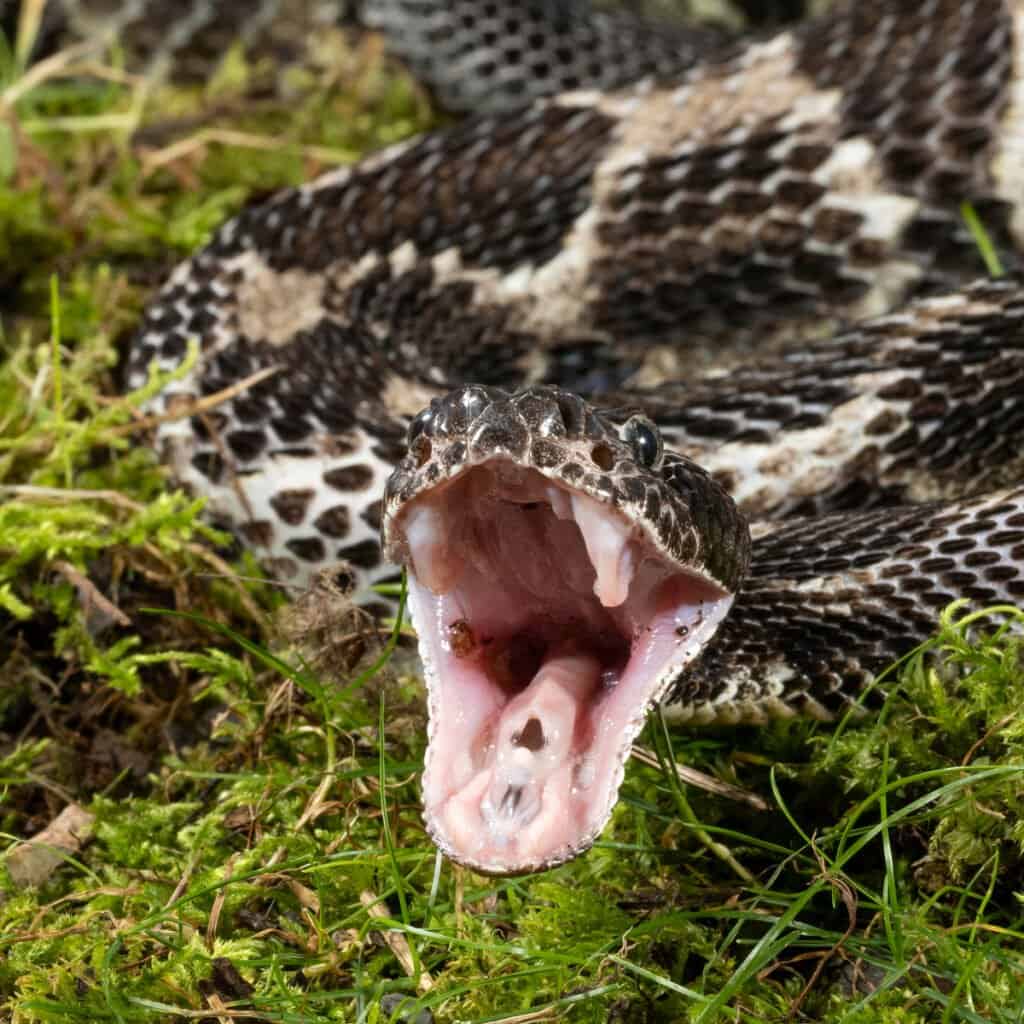
Make sure to keep an eye out for snakes when you’re outside. If you see a snake, the best thing to do is stay at least 6 feet away.
©Joe McDonald/Shutterstock.com
Although both timber rattlesnakes and eastern massasauga rattlesnakes are venomous and dangerous, they do not actively pursue or attack humans. In fact, these rattlesnakes are typically shy and try to avoid human encounters as much as they possibly can. When a rattlesnake bites a human, it is usually because the person did not see the rattlesnake and accidentally stepped on it.
If you do encounter a rattlesnake in New York, however, it is important to stay calm and not panic! Stay at least 6 feet away from the snake. Remember, these snakes are not aggressive and will only strike if thoroughly provoked. Never try to kill or collect a rattlesnake. Not only is it illegal, but you could be injured in the process. If the snake coils up and rattles its tail, stay calm; it is merely warning you to stay away. If you see a rattlesnake in a problematic, dangerous, or highly-populated area, call your regional wildlife office so they can relocate it safely.
If in the end you are accidentally bitten by one of these rattlesnakes, call 911 so that you can get medical attention right away. Remember to stay calm keep your heart rate low (do not run or panic), and never apply a tourniquet.
Although it’s important for doctors to know which snake bit you, a basic description and possibly a cell phone photo are often enough. There are only so many venomous snake species in a given area, so it’s usually easy to narrow it down. Do not try to kill the snake and bring it with you, because you’re likely to get bitten again. Hospitals have anti-venom for both types of rattlesnakes in New York.
The photo featured at the top of this post is © Scott Delony/Shutterstock.com
Discover the "Monster" Snake 5X Bigger than an Anaconda
Every day A-Z Animals sends out some of the most incredible facts in the world from our free newsletter. Want to discover the 10 most beautiful snakes in the world, a "snake island" where you're never more than 3 feet from danger, or a "monster" snake 5X larger than an anaconda? Then sign up right now and you'll start receiving our daily newsletter absolutely free.
Thank you for reading! Have some feedback for us? Contact the AZ Animals editorial team.






